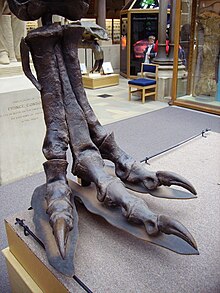Claw

A claw is a curved, pointed appendage, found at the end of a toe or finger in most mammals, birds, and some reptiles. Somewhat similar fine hooked structures are found in arthropods such as beetles and spiders, at the end of the leg or tarsus for gripping a surface as the creature walks. However, the word "claws" is most often used in reference to an invertebrate. For example, the crab's and lobster's claws or pincers, or more formally, their "chelae".
A claw is made of hard protein called keratin. Claws are used to catch and hold prey in carnivorous mammals such as cats and dogs, but may also be used for such purposes as digging, climbing trees, etc, in those and other species.
Similar appendages which are flat and do not come to a sharp point are called nails instead.
Arthropods
The correct term for an arthropod's 'claw' is a chela (plural chelae). Legs bearing a chela are called chelipeds. Chelae are also called pincers.
Tetrapods

In tetrapods, claws are made of keratin and consist of two layers. The unguis is the harder external layer, which consists of keratin fibers arranged perpendicular to the direction of growth and in layers at an oblique angle. The subunguis is the softer, flaky underside layer whose grain is parallel to the direction of growth. The claw grows outward from the nail matrix at the base of the unguis and the subunguis grows thicker while travelling across the nail bed. The unguis grows outward faster than the subunguis to produce a curve and the thinner sides of the claw wear away faster than their thicker middle, producing a more or less sharp point. Tetrapods use their claws in many ways, commonly to grasp or kill prey, to dig and to climb and hang.
Birds
A talon is the claw of a bird of prey, its primary hunting tool. The talons are very important; without them, most birds would not be able to catch their food.
Mammals
A nail is homologous to a claw but is flatter and has a curved edge instead of a point. A nail that is big enough to bear weight is called a 'hoof' (see also Horse hoof. However, one side of the cloven-hoof of artiodactyl ungulates may also be called a claw).

Every so often, the growth of claws stops and restarts, as does hair. In hair, this results in the hair falling out and being replaced by a new one. In claws, this results in an abscission layer, and the old segment breaks off. This process takes several months for human thumbnails. Cats are often seen working old unguis layers off on wood or on boards made for the purpose. Ungulates' hooves wear or self-trim by ground contact. Domesticated equids (horses, donkeys and mules) usually need regular trimming by a farrier, as a consequence of reduced activity on hard ground.
Many predatory mammals have protractile (protractable) claws that can partially hide inside the animal's paw, especially the Felidae, where almost all of its members have fully protractible claws.
Primates
A primate's nail consists of the unguis alone; the subunguis has disappeared. Much like the tail, the claw in apes is no longer necessary. However, in some individuals the subunguis has redeveloped to form a claw-like structure. These individuals don't have actual claws, instead the unguis appears normal with the addition of a thick growth of subunguis. However some lemurs have a toilet-claw.
See also
External links
- The Horse's Hoof Anatomy
- Rat's Claws, also explains much about mammalian claws in general.
